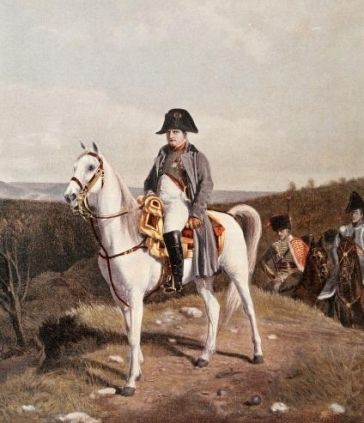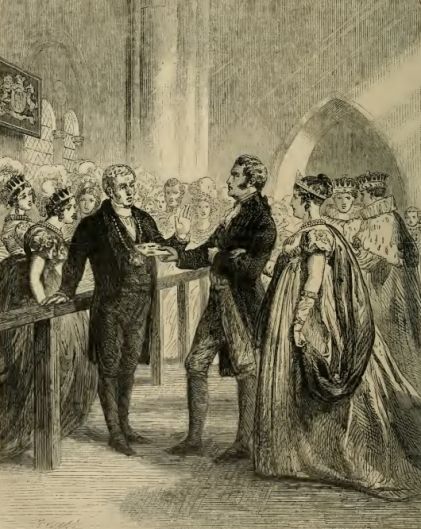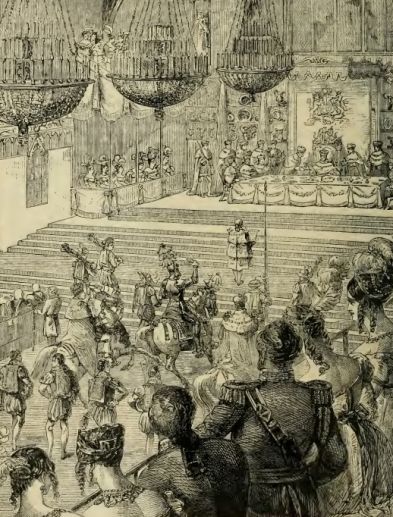On November 29th 1820, the Queen attended
a service of thanksgiving at St Paul’s Cathedral. The seven miles between
Brandenburg House (where she was then lodging) and the cathedral were lined
with cheering crowds (some estimates put their number in excess of half a million
people), all of them wearing white satin cockades or ribbons in support of the
Queen. In Carlton House, King George IV was beside himself with anger at the
failure of Government to supply him with the Bill he had wanted so much.
He railed against the members of both Houses; when Prince Leopold, his son-in-law, visited the Queen, the King cut him off and refused to speak to him thereafter. Later, in May 1821, it was announced to him that, “His Majesty’s greatest enemy is dead.” He replied with the words, “Thank God she is dead.” He thought, wrongly, that Caroline had died; the ‘greatest enemy’ was, in reality, Napoleon Bonaparte.
 |
| George IV |
He railed against the members of both Houses; when Prince Leopold, his son-in-law, visited the Queen, the King cut him off and refused to speak to him thereafter. Later, in May 1821, it was announced to him that, “His Majesty’s greatest enemy is dead.” He replied with the words, “Thank God she is dead.” He thought, wrongly, that Caroline had died; the ‘greatest enemy’ was, in reality, Napoleon Bonaparte.
 |
| Would the Real Greatest Enemy Please Stand Up? |
The
animosity continued – for instance, the exclusion from the Liturgy, enacted in
May 1820, remained in force. In July 1821, the Coronation of George IV was
planned to take place, and the Queen moved into lodgings near to Westminster
Abbey. On the morning of 19th, she was driven in a plain carriage to
the Abbey and alighted at the place designated for those attending the ceremony.
Accompanied by Lord Hood, Lady Wood and Lady Anne Hamilton, she approached the
door, where she was stopped by an official with the words,
Lord Hood pointed out that she was the Queen of England, but was told that anyone without a Peer’s ticket would not be admitted. Hood produced a ticket, signed ‘Wellington’, which he handed to Caroline, only to be told that it would only admit one person. Caroline refused to enter without Lady Wood and Lady Hamilton, and they all went to the door of the other cloister where, again, she was turned away. She attempted to enter through Westminster Hall, where she was faced by armed men with bayonets, which were held under her chin, until the door was slammed shut against her. Finally, she tried to get into the Abbey by a side door near Poets’ Corner, and once again she was turned away. At the advice of Sir Robert Inglis, she returned to her carriage and was driven back to Brandenburg House. The whole sorry rigmarole was watched by an embarrassed, silent crowd, as the visibly shaken Queen, almost reduced to tears, was thwarted by her vengeful King.
That night, before retiring, she took a glass of water, to which she added so much magnesia that it almost formed a paste, together with a few drops of laudanum. Lady Hamilton begged her not to drink this, but she insisted, claiming that it was the only way that she would be able to sleep, and it was only with the help of a spoon that she managed to take the concoction. The following day, she was ill and when, over a week later, she went to the theatre in Drury Lane, she fainted during the performance and had to be brought back to Brandenburg House. Over the next week, her condition deteriorated until, at twenty-five minutes past ten on the evening of August 7th 1821, she died from ‘internal inflammation.’ The general consensus was that her treatment at the Abbey had been the straw that finally broke her spirit. She had expressed the wish that, following her death, her body be taken back to Brunswick and should be buried in a tomb bearing the words,
The Government, anxious not to upset the King, planned for the route of the coffin to circumvent the City of London on its journey to Harwich, but they had reckoned without the English mob. All that remained in the public’s heart was a blistering indignity at the insults heaped upon Caroline in life by her hated, bloated buffoon of a husband, and when the cortège reached Kensington church, wagons had been placed across the planned route and their wheels removed. Trenches were dug in the roads, water pipes were opened and the authorities had no other option but to pass to the south side of Hyde Park. To cries of ‘Shame’ and ‘Through the City’, the mob forced the procession away from the Park and toward Cumberland Gate.
A troop of Life Guards were called out, and the situation promised to descend into a riot when two men were shot, but every street and side-street were deliberately blocked with carts and coaches, giving the cavalcade no other option but to pass along the City Road, along the Strand and through the City. On August 16th, the casket was loaded on board the frigate Glasgow and shipped to Stade, from whence it passed to Brunswick, where Caroline’s remains were interred in the cathedral vault of the House of Brunswick on August 26th, at midnight (as was the custom). R.I.P.
“We have no instructions to allow you to pass.”
 |
| Queen Charlotte refused entry to Westminster Abbey |
Lord Hood pointed out that she was the Queen of England, but was told that anyone without a Peer’s ticket would not be admitted. Hood produced a ticket, signed ‘Wellington’, which he handed to Caroline, only to be told that it would only admit one person. Caroline refused to enter without Lady Wood and Lady Hamilton, and they all went to the door of the other cloister where, again, she was turned away. She attempted to enter through Westminster Hall, where she was faced by armed men with bayonets, which were held under her chin, until the door was slammed shut against her. Finally, she tried to get into the Abbey by a side door near Poets’ Corner, and once again she was turned away. At the advice of Sir Robert Inglis, she returned to her carriage and was driven back to Brandenburg House. The whole sorry rigmarole was watched by an embarrassed, silent crowd, as the visibly shaken Queen, almost reduced to tears, was thwarted by her vengeful King.
 |
| The Coronation of George IV |
That night, before retiring, she took a glass of water, to which she added so much magnesia that it almost formed a paste, together with a few drops of laudanum. Lady Hamilton begged her not to drink this, but she insisted, claiming that it was the only way that she would be able to sleep, and it was only with the help of a spoon that she managed to take the concoction. The following day, she was ill and when, over a week later, she went to the theatre in Drury Lane, she fainted during the performance and had to be brought back to Brandenburg House. Over the next week, her condition deteriorated until, at twenty-five minutes past ten on the evening of August 7th 1821, she died from ‘internal inflammation.’ The general consensus was that her treatment at the Abbey had been the straw that finally broke her spirit. She had expressed the wish that, following her death, her body be taken back to Brunswick and should be buried in a tomb bearing the words,
“Here lies Caroline of Brunswick, the injured Queen of England.”
 |
| Banquet following the Coronation of George IV |
The Government, anxious not to upset the King, planned for the route of the coffin to circumvent the City of London on its journey to Harwich, but they had reckoned without the English mob. All that remained in the public’s heart was a blistering indignity at the insults heaped upon Caroline in life by her hated, bloated buffoon of a husband, and when the cortège reached Kensington church, wagons had been placed across the planned route and their wheels removed. Trenches were dug in the roads, water pipes were opened and the authorities had no other option but to pass to the south side of Hyde Park. To cries of ‘Shame’ and ‘Through the City’, the mob forced the procession away from the Park and toward Cumberland Gate.
 |
| Catalogue of the Sale of Queen Caroline's Furniture and Effects |
A troop of Life Guards were called out, and the situation promised to descend into a riot when two men were shot, but every street and side-street were deliberately blocked with carts and coaches, giving the cavalcade no other option but to pass along the City Road, along the Strand and through the City. On August 16th, the casket was loaded on board the frigate Glasgow and shipped to Stade, from whence it passed to Brunswick, where Caroline’s remains were interred in the cathedral vault of the House of Brunswick on August 26th, at midnight (as was the custom). R.I.P.
No comments:
Post a Comment